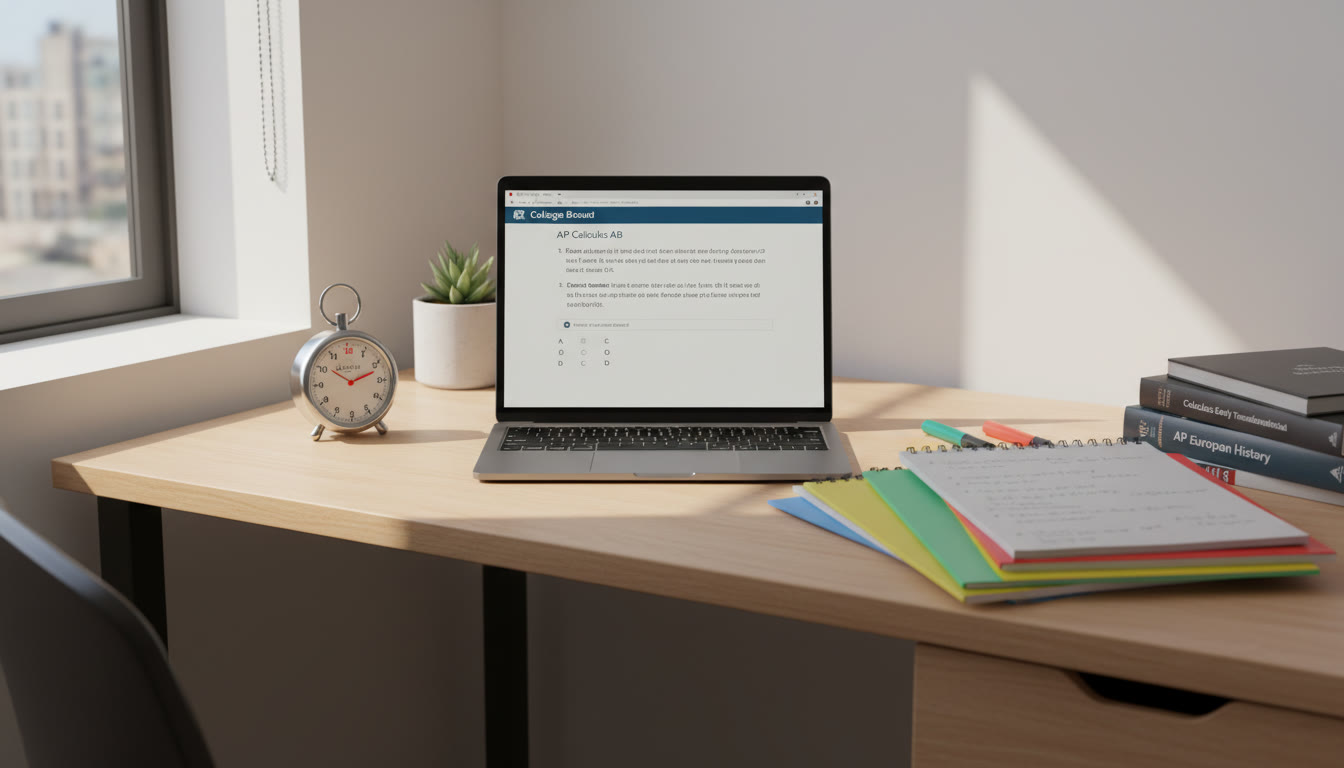Why This Guide Exists (and Why It’s For You)
If you’re an AP student with ADHD, you already know the challenge: dense content, long study sessions, timed exams, and a brain that doesn’t reliably obey a rigid schedule. That can feel overwhelming, but it also means you need different—not lesser—strategies. This post is a friendly, practical playbook: bite-sized focus tactics, scheduling hacks, calming rituals, and test-day options you can actually try. I’ll share examples that work for real students, comparisons so you can pick what fits your brain best, and a simple table to help you design a weekly plan. Where it fits naturally, I’ll mention how Sparkl’s personalized tutoring can support 1-on-1 guidance, tailored study plans, and AI-driven insights to make these strategies stick.
How ADHD Changes the Game for AP Preparation
ADHD frequently affects attention regulation, working memory, and the ability to sustain effort on low-stimulation tasks. AP classes amplify those issues: long readings, timed writing, multi-step problem solving, and high-stakes testing. But ADHD also brings strengths—creativity, hyperfocus in the right conditions, and the ability to connect ideas in novel ways. The goal is to structure your study in a way that minimizes the friction that trips you up and maximizes conditions where your attention thrives.
Common pain points AP students with ADHD report
- Difficulty starting long readings or practice exams.
- Mind wandering during lectures or video lessons.
- Difficulty tracking time during practice or the real exam.
- Overwhelm when faced with long-term projects or cumulative review.
- Frustration when study plans are rigid and don’t match fluctuating focus.
Core Principles of ADHD-Friendly Study
Before tactics, adopt guiding principles you can return to when motivation dips:
- Break big tasks into ridiculously small, visible steps.
- Leverage short, intense bursts more than long, low-energy sessions.
- Prioritize progress over perfection—consistent micro-progress beats occasional marathon sessions.
- Pair effort with immediate, small rewards (a bite of favorite snack, 5 minutes of a game, a quick stretch).
- Use environmental cues and remove common distractions ahead of time.
What “small steps” look like
- Instead of “study AP Biology,” write: “Read 2 pages from unit 3, highlight 3 key terms, and write one quiz question.”
- Instead of “review essays,” write: “Outline a 10-minute plan for a sample FRQ, then free-write for 8 minutes.”

Concrete ADHD-Friendly Focus Strategies
1. Micro-Blocks with Intentional Pauses (The 20/5/20 Model)
Short, intentional work blocks with mandatory breaks reduce cognitive fatigue and keep momentum. One useful pattern: 20 minutes of focused study, 5 minutes of active break (walk/stretch), and a 20-minute reflection or retrieval practice. This structure lets you cycle attention: work, recover, and consolidate.
- Set a visible timer that counts down—phones with focus modes or simple kitchen timers work well.
- During the 5-minute break, move your body; avoid social media unless it’s a strict 60-second check that you stop on time.
2. Use the “Two-Minute Start” to Beat Inertia
Getting started is often the hardest step. Promise yourself two minutes: read the first paragraph, do two practice problems, or write one sentence of an essay. Often, the two minutes turn into forty. Even if they don’t, you’ve won a psychological victory that loosens resistance for next time.
3. Alternate Modes of Study to Prevent Boredom
Switching between reading, active recall, drawing diagrams, and speaking aloud keeps novelty high. For example, spend 15 minutes reading, 10 minutes making a concept map, and 10 minutes explaining the concept out loud like you’re teaching a friend.
4. Retrieval Practice Over Passive Re-Reading
Active recall—testing yourself without notes—builds stronger memory. Use flashcards, closed-book quick quizzes, or practice with a friend who asks questions. Turn reading material into 3–5 self-quiz prompts and answer them from memory.
5. Design Your Environment to Reduce Decision Fatigue
Make the right action the default. That means a clean desk, headphones for focus playlists, water bottle nearby, and a quick checklist on sticky notes that tells you exactly what to do first. Pre-decision removes friction: instead of choosing between tasks, you follow the checklist.
Planning and Time Management That Works With ADHD
Traditional planners often fail because they demand long-term, consistent adherence. Try flexible, visual systems that honor variability.
Weekly Board + Daily Tiny List
Use a whiteboard or digital kanban with 3 columns: This Week, Today, Done. Each week, move 3–5 high-priority tasks into Today—tasks that are concrete and achievable in short sessions. End each day by moving unfinished items back to This Week or splitting them into smaller pieces.
Example Weekly Layout
| Day | AP Goals (Concrete) | Focus Blocks | Reward |
|---|---|---|---|
| Monday | Read 2 sections of AP US History, create 5 flashcards | 3 x 25/5 | 15-minute guitar practice |
| Wednesday | Timed practice FRQ (30 min), review rubric | 1 x 30 work, 10 reflection | Favorite snack + short walk |
| Friday | Complete AP Calculus problem set #7 (5 problems) | 2 x 20/5 | Movie night |
How to choose focus block durations
- If long blocks feel impossible: start at 12–15 minutes and increase gradually.
- If you can enter hyperfocus: schedule it for harder topics and set an alarm to avoid overrun and burnout.
Study Techniques That Fit ADHD Brains
Multisensory Encoding
Encode material in multiple ways: read aloud, sketch diagrams, and use color coding. For example, in AP Biology, color-code systems (blue for circulatory, green for photosynthesis terms) and say processes aloud while drawing arrows. The richer the sensory trail, the easier retrieval becomes under stress.
Interleaving and Spaced Review
Rather than massed practice (doing only calculus for four hours), interleave subjects across sessions and space reviews across days. Create a simple calendar that rotates subjects—this increases long-term retention and keeps study sessions novel.
Simulated Exam Conditions With Micro-Adaptations
Practice under conditions similar to test day, but use small accommodations during training: allow yourself extra breaks, use a quiet buzzer, or practice with a laptop if that’s an approved tool. Over time, shrink those allowances to adapt to the actual exam environment—unless you have approved accommodations for the real test.
Managing Stress, Motivation, and Burnout
The 3-Minute Reset
When stress spikes, have a simple reset: 60 seconds of box breathing (4 in, 4 hold, 4 out), 60 seconds of light stretching, and 60 seconds to list three concrete next steps. This quick routine lowers physiological arousal and rebuilds agency.
Reward Systems That Don’t Backfire
Rewards work best when paired with clear progress markers. Instead of “watch Netflix after studying,” try a tiered reward: 20 minutes of focused work = 10 minutes of music; two 20-minute sessions = 30 minutes of streaming. Keep rewards proportional and predictable.
Using Technology Wisely
Tools That Help (Not Hurt)
- Focus timers (Forest, simple Pomodoro apps) that visualize progress.
- Text-to-speech for long passages to reduce reading fatigue.
- Voice recording apps to capture quick memory dumps after lessons.
- Ad blocker or site-blocking apps during focus blocks.
When Tech Becomes a Distraction
Designate a study device (tablet for reading, laptop for practice) and remove social apps during blocks. If you use a phone as a timer, enable Do Not Disturb with exceptions for alarms only.

Exam Day Strategies for Students with ADHD
Pre-Exam Ritual
Build a calm, predictable routine the morning of the exam: consistent wake time, protein-rich breakfast, quick review of 3 KEY ideas (not everything), and a short movement session (jumping jacks or a brisk walk). Ritual reduces anticipatory anxiety and primes attention.
Time Management During the Exam
- Skim the entire exam quickly to map difficulty and prioritize questions.
- Use a visual timing plan: allocate minutes per section and mark checkpoints on the test paper (e.g., at 30 minutes, aim to be through question 22).
- If you’re allowed extra time through accommodations, practice pacing with that time during prep so you know the rhythm.
Handling Intrusive Thoughts or Panic
If anxiety intrudes, use a 30-second grounding trick: press your feet into the floor, count five objects in the room, and take three measured breaths. Then return to the next easiest task you left unfinished—small wins rebuild confidence.
Accommodations: When and How to Ask
If ADHD impacts your standardized testing performance, you may be eligible for accommodations (extended time, extra breaks, a separate room, or assistive tech). Start the request early—often through your school’s SSD coordinator—and provide current, clear documentation about how ADHD affects your testing. Approved accommodations can be transformative; they level the playing field so your knowledge—not your symptom management—determines results.
Tips for the accommodations process
- Start discussions early—ideally at the beginning of the school year.
- Document how accommodations helped you in classroom testing and coursework.
- Keep copies of IEP/504 plans and recent evaluations handy during the application process.
Real Student Examples (What Worked)
Case 1: Maya, AP Chemistry
Maya found long practice problems exhausting. She shifted to 20-minute micro-blocks and used a whiteboard to sketch reactions visually. During practice, she recorded herself explaining steps and replayed those clips before bed. Her retention soared because she combined multisensory encoding with short, intense review.
Case 2: Jamal, AP US History
Jamal struggled to read long chapters. He started listening to accelerated audio versions at 1.25x speed while making a one-page timeline afterward. He paired that timeline with two retrieval self-quizzes. This method turned passive reading into active synthesis.
How personalized tutoring amplified results
Both students benefited when they used Sparkl’s personalized tutoring for targeted support: one-on-one guidance to design tailored study plans, expert tutors who modeled active recall techniques, and AI-driven insights that helped identify weak topics and the best practice problems to fix them. Personalized coaching helped keep momentum and adapt strategies when something stopped working.
Weekly Planner Template You Can Copy
| Time | Monday | Wednesday | Friday |
|---|---|---|---|
| 4:00–4:30 PM | 20/5/20 Unit Review (AP Bio) | 20/5/20 FRQ practice (AP Eng) | 20/5/20 Problem Set (AP Calc) |
| 5:00–5:30 PM | Flashcards + Retrieval | Timed Essay Draft | Practice Multiple Choice |
| 8:00–8:30 PM | Light Review + Reflection | Self-Quiz | Plan Next Week |
How to Know If a Strategy Is Working
Use simple, measurable indicators: more completed study blocks per week, improved accuracy on practice sets, decreased time to start a task, or reduced exam-day panic. Track one or two metrics for a month and adjust. If a strategy drains energy without measurable benefit after 2–3 weeks, try a variation instead of doubling down.
Final Tips: Be Kind, Be Curious, Be Flexible
Studying with ADHD is a long-term design problem—not a flaw. Some days you’ll have hyperfocus and get more done than you expected. Other days you’ll be tired and only manage the Two-Minute Start. Both are fine. Collect strategies, test them for a few weeks, keep what helps, tweak what doesn’t.
If you want structured help, consider sparking your plan with personalized tutoring—Sparkl’s tutors can design 1-on-1 sessions, create tailored study plans that use these ADHD-friendly tactics, and provide AI-driven insights to track progress. The combination of human coaching and data-driven tweaks often accelerates improvement because it blends accountability with individualized technique.
Quick Checklist to Start Tomorrow
- Choose one subject and define a single, tiny goal (example: 2 AP Bio pages + 3 flashcards).
- Set a timer for a Two-Minute Start followed by a 20/5 focus cycle.
- Design a small reward for completing two cycles.
- Sketch a one-week mini-plan on a whiteboard with Today/This Week/Done columns.
- Decide whether to pursue accommodations and talk to your school’s SSD coordinator if this applies to you.
Parting Thought
AP exams ask for endurance and depth—but studying for them doesn’t have to look like endless, joyless hours. With ADHD, the key is to experiment with structure that fits your rhythms: tiny wins, constant feedback, and human support when you need course correction. Use these strategies as a toolkit—try one, tweak it, and stack techniques over time. You’ll be surprised how much steady, small change adds up by the time exams arrive.
If you’d like, I can help you build a personalized week-long plan right now—tell me your AP subjects, typical study hours per day, and what’s been hardest so far, and we’ll design an ADHD-friendly plan together.


















No Comments
Leave a comment Cancel